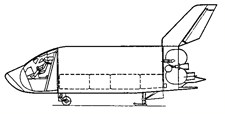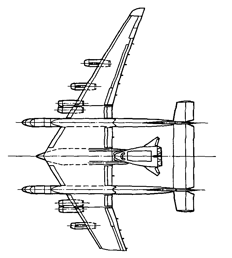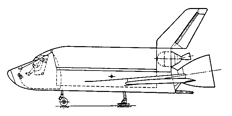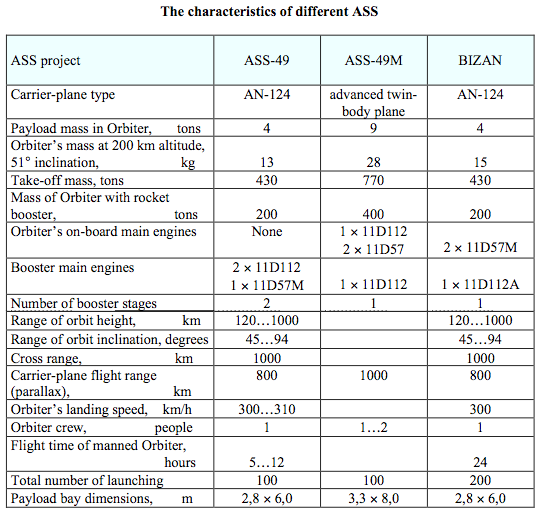

- Documentation
- Table of contents
- AKC
- Introduction
- Airframe Creation
- Technological Problems
- Experimental plant
- Building plant
- Conf. Development
- Aerodynamic Designing
- Algorithms of control
- Guidance & control
- Stand for training
- Training center
- Horizontal flight tests
- Crew on board
- Auto Landing complex
- Structure
- Payload bay
- Metallic material
- Non metallic material
- Non metallic material
- Cabin assembly
- Thermal designing
- Thermal protection
- Heat protection
- Quartz fibre
- Computer designing
- Gas's dynamic
- Strength
- Basic direction
- Tech. preparation
- Technical diagnostics
- Methods & means
- Radio nav. support
- Information & controls
- Control of onboard equ.
- Electric power dist.
- Electromagnetic
- Antennas installation
- Auxiliary power unit
- Hydraulic system
- Cabin
- Safety
- Air transportation
- Automatic landing
- Exp. working out
- Return to space
- SPIRAL
- Analysis of concept
- Horizontal take-off
- BOR-4 & BOR-5
- MAKS multipurpose
- MAKS-D
- Thermal design
- Gas & thermal design
- Wing deflection
- Flight performance
- Maks structure
- Metal materials
- Advanced non metallic
- Information provision
- Onboard starting comp.
- Onboard control comp.
- Control organization
- Aerospace systems
- Economic investigations
- Triplane aircraft
- Technical inventions
- Scientific potential
- Triumph and tragedy
- Birds of a Feather?
- TsAGI wind tunnel
- Bibliography
| -The Mriya is destroyed. |
| -Shipping of Buran-KS to Sotchi. |
| -Antonov is no more. |
| -Buran is now a museum. |
| -New pictures of the blogger Ralph Mirebs. |
From SPIRAL to MAKS
Horizontal Take-off Two-Stage Aerospace Transport Systems
Kutyakin E.P.
The works on improving characteristics of the Aerospace Transport Systems are described at transition from the SPIRAL system with hypersonic booster-plane of small lift capacity to the ASS-49, BIZAN and MAKS systems with subsonic Carrier-Plane ensuring considerably greater lift capacity.
In addition to the BURAN Orbiter’s development NPO MOLNIYA Scientific & Industrial Enterprise was carrying out many investigations on improving technical characteristics of Aerospace System (ASS). This system is intended for the small-size multipurpose orbital plane’s (OP) injection into an orbit to perform certain missions, as well as for injection automatic space vehicles (SV) of different purposes.
For fast realization of this project, in contrast to the SPIRAL aerospace system with the hypersonic booster-plane, the decision was accepted to develop the aerospace system (ASS) on the basis of the existing subsonic Carrier-Plane (CP). This CP, being of a high lift capacity, would be able to launch the ASS second stage with more mass of payload as compared with the SPIRAL system.
In 19761981 technical specifications of the ASS versions and range of their expedient applications were determined. The major requirements to ASS have been developed: carrier-plane flight range, minimization of aerodynamic drag and external structure’s loads, maximum payload-to-launch ratio, exclusion of an adapter modules, possibility to cancel a launch, short pre-launch period and flight times and others. Intensive analysis has been carried out to find new constructional material and to work out technical requirements for them to guarantee reliable operation of the ASS. Very complex problem connected with creation of a multipurpose orbital plane was being solved. This OP should be used to fulfill three different functions:
- to inject payloads into the space;
- to work in space as an artificial satellite;
- to descent from orbit and to recover payloads.
The ASS-49 Aerospace System
In accordance with a government decision, NPO MOLNIYA in 1981 has developed the project of the ASS-49 aerospace system with carrier-plane on the basis of the AN-124 RUSLAN transport aircraft (Figure 1). This project was designed in a close cooperation with TsAGI as well as with experimental-design bureaus named after O.K. Antonov, N.D. Kuznetsov, A.M. Ljulka, N. A. Pilugin and many other enterprises.

|
|
Figure 1. ASS-49 system with AN-124 carrier-plane |
The results of wind tunnel tests, flight tests of the SPIRAL orbiter when it was dropped from TU-95 bomber and successfully performed launchings of the BOR-4 large-scale flight model as well as researches fulfilled on the BURAN Orbiter were used in this project. The major aim of this project was to create the profitable reusable aerospace transport system with a low cost of the payload injection, ensuring possibility of an active operation on orbit and a recovery. This system in condition of low financing can extend the range of research and commercial programs due to relatively low level of operation cost.
The researches showed that in accordance with received technical request for proposal this system was appeared to be cheaper and more comfortable in operation than the expendable launch systems.
The usage of carrier-plane in capacity of mobile launch platform provides to launch the orbital plane (OP) and space vehicles (SV) on orbits of different inclinations, including equatorial and geo-stationary orbits if use in-flight refueling. Due to the mobile air start, the aerospace system ensures high efficiency of coming out to the given orbital object, thus extending the range of missions in comparison with rocket launcher, started from stationary launching site.
A lifting body configuration was chosen for the orbital plane (Figure 2), because one was well worked out by tests in wing tunnels and flight tests of the SPIRAL orbiter and the BOR-4 large-scale model.

|
|
Figure 2. Orbiter of the ASS-49 system |
This configuration due to wing panel rotation along longitudinal axis minimizes aerodynamic heat of a wing leading edge with a small bending radius and provides a good stability trough hypersonic flight. This configuration maximizes also an internal volume providing the required lift-to-drag ratio in the range of main operational angles of attack. The orbital plane of 13-tons takeoff mass is able to launch into low Earth orbit of (51 inclination) the payload of 4 tons mass and 0,15 kg/liter density.
The start from AN-124 is made at the altitude of about 10 km, and the OP or VS launching into an orbit is carried out by means of a two-stage rocket booster. In this case it is needed alienated fields on the ground for drop-away booster. It was proved that in optimal case the liquid rocket engine (LRE) fuel for the first stage booster should have a high density (oxygen + kerosene) and fuel for the second stage should have a high specific impulse (hydrogen + oxygen).
Two-stage booster is designed in two different versions: a traditional ‘tandem’ scheme when the stages are connected one by one and so called ‘piston’ scheme when second-stage booster is placed into a ‘torus’- shape tank compartment of the first-stage booster.
The take-off mass of the whole system in the ASS-49 project was approximately 430 tons, including the mass of OP with rocket booster – 200 tons, that necessitated to increase a lift capacity of the base plane carrier-plane.
The necessity of alienated fields on the ground made this project to be non-perspective. It was decided to concentrate on development of one-stage rocket booster, which doesn’t need the mentioned-above alienated fields on the ground.
The ASS-49M Aerospace SystemSimultaneously with the ASS-49 aerospace system the project of a high-weight aerospace system (ASS-49M) was developed. It was based on the advanced heavy twin-body carrier-pane (Figure 3) with 770-tons ASS total take-off mass and 370-tons carrier-plane mass. The second stage of this system consists of OP and hanging tank unit. In addition three of four main liquid rocket engines (LRE) (two 11D57 and one 11D112) are installed on OP. They are reusable engines (on hanging tank unit one 11D112 is installed). Such decision results in increase of economical efficiency of the operation of whole system. The ASS-49M system provides injection into the 200-km orbit of 51° inclination for the orbital plane with 28-tons total mass and payload, located in OP, up to 9 tons.
The conception of heavy twin-body carrier-plane has been developed further in the known HERACLES project .

|
|
Figure 3. The ASS-49М system with advance heavy twin-body carrier-plane |
BIZAN Aerospace System
On the basis of worked out researches the decision was made about further works on the aerospace system based on the An-124 carrier-plane. The task of research on the BIZAN system was improving the performances of existing projects of the aerospace system (ASS).
In 1982 the project of BIZAN system was released where ASS scheme was considerably improved (Figure 4).
The rocket booster, injecting OP or SV into an orbit, was one-stage, and consequently it didn’t need alienated fields on the ground. Oxygen, hydrogen and kerosene were used as fuel components. In general, the OP construction stayed the same as in the ASS-49 system (Figure 5). The AN-124 (RUSLAN) plane was used as a carrier aircraft.

|
|
Figure 4. BIZAN aerospace system with AN-124 carrier-plane |
The one-stage rocket booster of the BIZAN system during the OP or SV launching into an orbit doesn’t inject itself into orbit, but falls in an antipodal point of the World Ocean, thus not pollute neither space nor Earth ground surface. In such condition payload mass stays the same as in the ASS-49 project with two-stage booster.

|
|
Figure 5. Orbiter of the BIZAN system |
Simultaneously, for BIZAN-T cargo version the SV installation on rocket booster layout was worked out (Figure 6). This scheme has become a prototype for the MAKS-T future system.
The researches on ASS-49 and BIZAN systems were conducted by the great group of high-qualified specialists mainly under the direction of Mr.: Seletskiy Y.I, Samsonov E.A., Voinov L.P., Tarasov A.T.

|
|
Figure 6. Cargo version of BIZAN-T second stage |
The major characteristics of ASS-49, ASS-49М and BIZAN systems are presented in the following table. It shows that these systems have quite high level of capabilities.
When An-225 MRIA transport aircraft with 250…275-tons lift capacity was designed, a new stage of development of aerospace systems with subsonic carrier-plane has appeared.
NPO MOLNYA has developed the project of the MAKS system on the basis of ASS-49 and BIZAN experience.

|